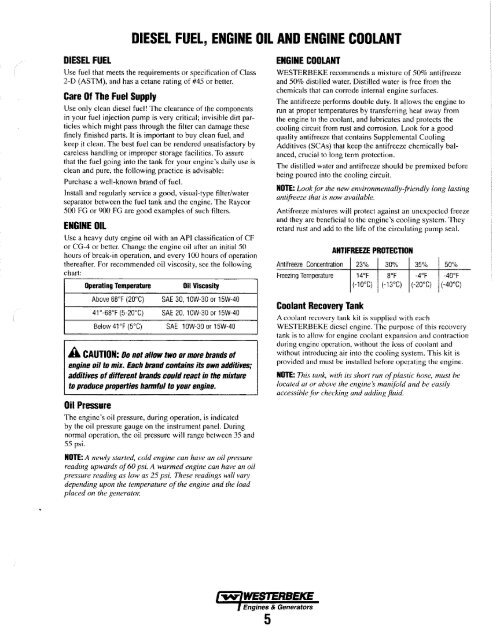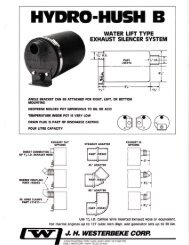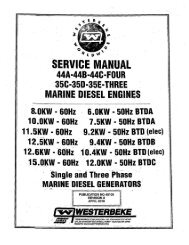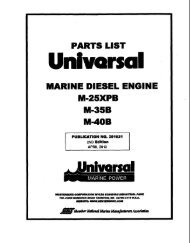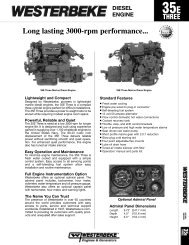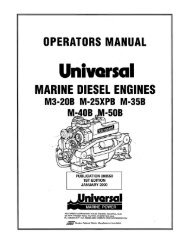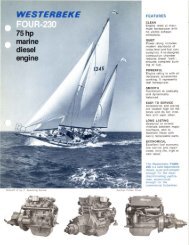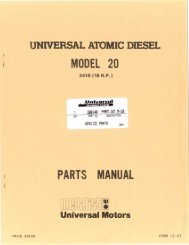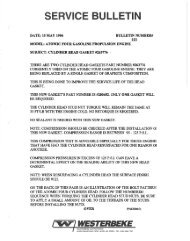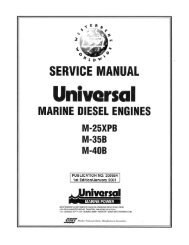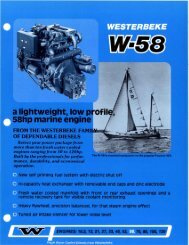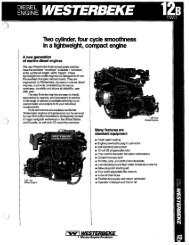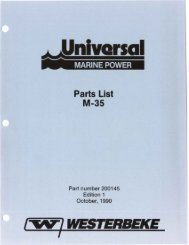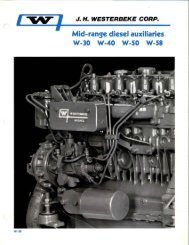OPERATORS MANUAL - Westerbeke
OPERATORS MANUAL - Westerbeke
OPERATORS MANUAL - Westerbeke
You also want an ePaper? Increase the reach of your titles
YUMPU automatically turns print PDFs into web optimized ePapers that Google loves.
DIESEL FUEL<br />
DIESEL FUEL, ENGINE OIL AND ENGINE COOLANT<br />
Use fuel that meets the requirements or specification of Class<br />
2-D (ASTM), and has a cetane rating of #45 or hetter.<br />
Care Of The Fuel Supply<br />
Use only clean diesel fuel! The clearance of the components<br />
in your fuel injection pump is very critical; invisible dirt particles<br />
which might pass through the filter can damage these<br />
finely finished parts. It is important to buy clean fuel, and<br />
keep it clean. The best fuel can be rendered unsatisfactory by<br />
careless handling or improper storage facilities. To assure<br />
that the fuel going into the tank for your engine's daily use is<br />
clean and pure, the following practice is advisable:<br />
Purchase a well-known brand of fuel.<br />
Install and regularly service a good, visual-type filter/water<br />
separator between the fuel tank and the engine. The Raycor<br />
500 FG or 900 FG are good examples of sueh filters.<br />
ENGINE OIL<br />
Use a heavy duty engine oil with an API classification of CF<br />
or CG-4 or better. Change the engine oil after an initial 50<br />
hours of break-in operation, and every 100 hours of operation<br />
thereafter. For recommended oil viscosity, sec the following<br />
chart·<br />
Operating Temperature Oil Viscosity<br />
Above 68°F (20°C) SAE 30. 1 OW·30 or 15W-40<br />
41°-68°F (5·20°C) SAE 20. 1 OW·30 or 15W-40<br />
Below 4n (SoC) SAE 1 OW·30 or 15W·40<br />
A CAUTION: 00 not allow two or more brands of<br />
engine oil to mix. Each brand contains its own additives;<br />
additives of different brands could react in the mixture<br />
to produce properties hannful to your engine.<br />
Oil Pressure<br />
The engine's oil pressure, during operation, is indicated<br />
by the oil pressure gauge on the instrument panel. During<br />
normal operation, the oil pressure will range between 35 and<br />
55 psi.<br />
NOTE: A newly slarted, cold engine can have an oil pressure<br />
reading upwards of 60 psi. A warmed engine can have an oil<br />
pressure reading as low as 25 psi. These readings will vary<br />
depending upon the temperature of the engine and the load<br />
placed on the generator.<br />
ENGINE COOLANT<br />
WESTERBEKE recommends a mixture of 50% antifreeze<br />
and 50% distilled water. Distilled water is free from the<br />
chemicals that can corrode internal engine surfaces.<br />
The antifreeze performs double duty. It allows the engine to<br />
run at proper temperatures by transferring heat away from<br />
the engine to the coolant, and lubricates and protects the<br />
cooling circuit from rust and corrosion. Look for a good<br />
quality antifreeze that contains Supplemental Cooling<br />
Additives (SeAs) that keep the antifreeze chemically balanced,<br />
crucial to long term protection.<br />
The distilled water and antifreeze should be premixed before<br />
being poured into the cooling circuit.<br />
NOTE: Look for the new environmentally-friendly long lasting<br />
antifreeze that is now available.<br />
Antifreeze mixtures will protect against an unexpected freeze<br />
and they are beneficial to the engine's cooling system. They<br />
retard rust and add to the life of the circulating pump seal.<br />
Antifreeze Concentration<br />
Freezing Temperature<br />
ANTIFREEZE PROTECTION<br />
23%<br />
WF<br />
(-WOC)<br />
Coolant Recovery Tank<br />
30% 35% 50%<br />
A coolant recovery tank kit is supplied with each<br />
WESTERBEKE diesel engine. The purpose of this recovery<br />
tank is to allow for engine coolant expansion and contraction<br />
during engine operation, without the loss of coolant and<br />
without introducing air into the cooling system. This kit is<br />
provided and must be installed before operating the engine.<br />
NOTE: This tank, with its short run of plastic hose, must he<br />
located at or above the engine:5 manifold and he easily<br />
accessible for checking and adding fluid.<br />
Engines & Generators<br />
5


